| |
All photos are
thumbnails - click on the thumbnail to view the full-sized
picture
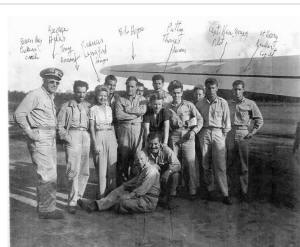
Snap shot of Bob Hope and aircrew during the ETO USO
Tour - Summer 1945. |
| |
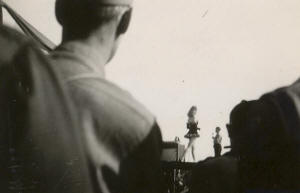 |
| |
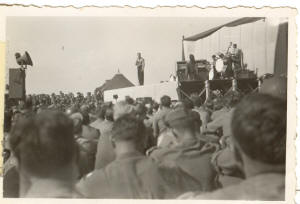 |
| |
 |
| |
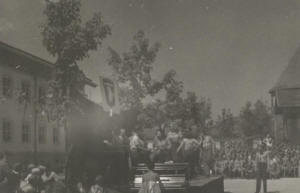 |
| |
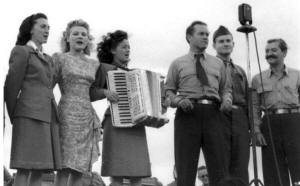 |
|
Francis Langford, flowered dress, Hope and Jerry Colonna at right
somewhere in Germany, 1945. There is no shortage of both Signal
Corps, press or private photos from Bob Hope’s 1945 tour - just none
from the Bad Kissingen show. |
| |
 |
|
Hope and dancer Patty Thomas at the Fritzlar stop of the tour. The
band members are seated behind screens marked at the top as 9th USAF
and then at the bottom “ s4s “ - the 4th Soldier Service Band. The
airfield was at the time, HQ for the 9th AF Fighter Command and 9th
Tactical Air Command.
Then a series of images from the show. |
| |
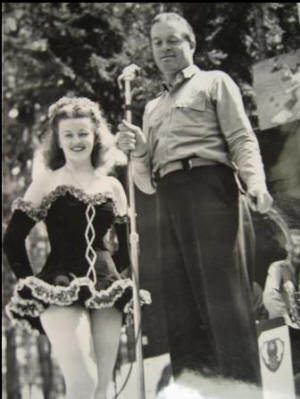 |
|
Another view of Hope and Thomas. |
| |
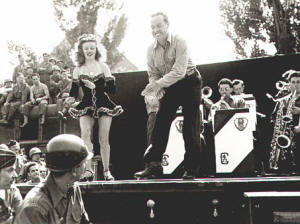 |
|
And a third snap shot of Hope and Thomas. |
| |
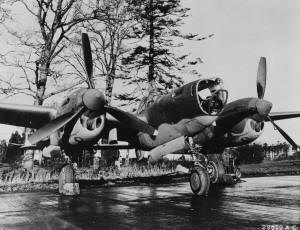 |
|
P38
Droop Snoot was a variation that allowed a second crewman into the
aircraft serving as a bombardier. This aircraft would lead a
formation of standard P38 aircraft to a target and then take the
proper direction and altitude for the final bombing run. When the
bombardier had made his final corrections, he would release his
bomb, the accompanying aircraft would then drop their bombs in
unison. |
| |
 |
|
Bob and a beaming Ruth Denas. |
| |
 |
|
Gail Robbins and Bob. |
| |
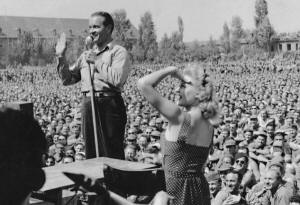 |
|
Second
image of this pair - all from the Fritzlar show. |
| |
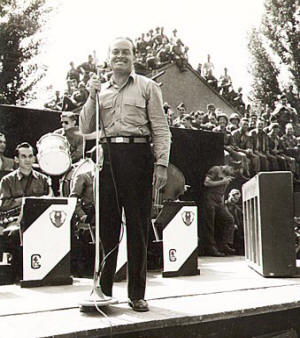 |
|
Bob commands the stage. |
| |
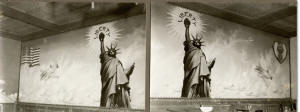 |
|
Seen here is the mural showing the Statue of Liberty painting in
Schweinfurt that Bob Hope commented on in his newspaper column. |
| |
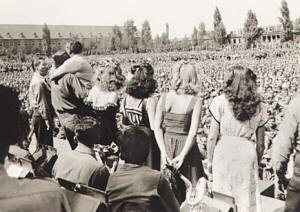 |
|
From left: Jerry Colonna, comedian Roger Price (in uniform), Bob
Hope ( he has just jumped into Price’s arms ) and the girls. |
| |
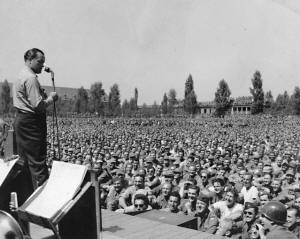 |
|
Amazing how many images turned up from that one show. |
| |
 |
|
Bob and Roger. |
| |
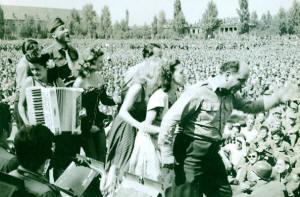 |
|
Leaving the stage as the show wraps up. From left: Jerry
Colonna (partially obscured), Roger Price (in uniform),
Ruth Denas (accordion), Patty Thomas, Bob Hope (partially obscured),
Gale Robbins, June Bruner and Jack Pepper. |
| |
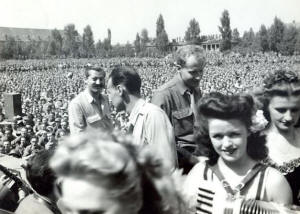 |
|
Colonna at left and Price at center, the girls in the foreground.
|
| |
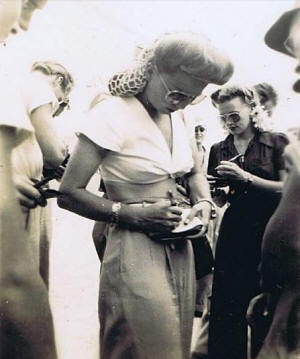 |
|
Francis Langford, a popular singer and entertainer and long time
member of the Bob Hope USO tour group signs an autograph for the
troops somewhere in the ETO, 1945. |
| |
 |
|
Gail Robbins |
| |
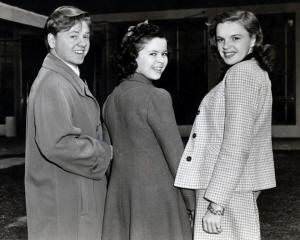 |
|
Mickey Rooney, Shirley Temple and Judy Garland, the biggest stars of
1939. |
| |
 |
|
Judy and Mickey in one of the very popular Andy Hardy movies. |
| |
 |
|
1942 and Mickey joins an Army band at the Hollywood Canteen, a club
and snack bar run by the stars for the benefit of the troops. |
| |
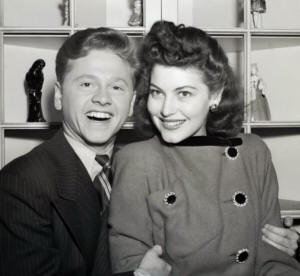 |
|
Mickey and Ava Gardner in 1943. He was a mega star, she was a bit
part player on the rise. |
| |
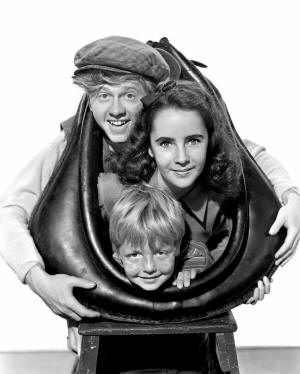 |
|
Publicity still from Mickey’s last movie, National Velvet with
Elizabeth Taylor, prior to reporting for active duty in 1944. |
| |
 |
|
PVT Rooney at basic training, Fort Riley. |
| |
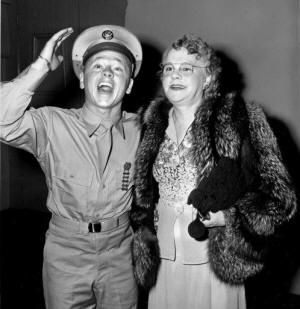 |
|
Mickey and mom, a short leave back in California prior to reporting
to Camp Seifert. |
| |
 |
|
Divorced from Ava, Mickey married the local beauty queen, Beatty
Jane Rase |
| |
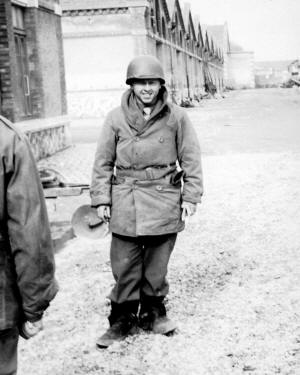 |
|
Somewhere in France or Germany, trooper Rooney |
| |
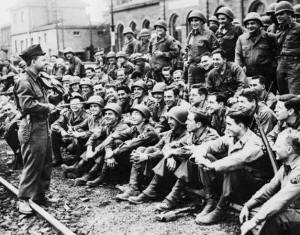 |
|
Rooney, assigned to the Show Company, performing for the troops
somewhere near the front lines. |
| |
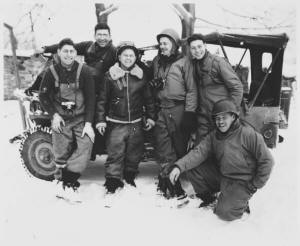 |
|
Mickey’s Jeep Show group with unaccredited talent and photographers. |
| |
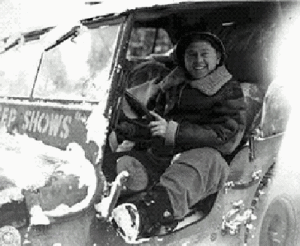 |
|
On the road - on the trails. |
| |
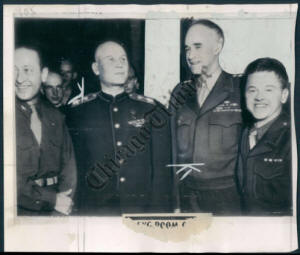 |
|
Shortly after the end of the war, Russian generals, Omar Bradley and
Mickey at Bad Wildungen, Germany. |
| |
 |
|
This is an Adobe PDF - click on the picture to view the full-sized
document
Mickey plays BK - the souvenir program from the Soldier Show Company
production of OK - USA staged in early September, 1945. |
|
|
 |
|
Mickey reunited with Beatty Jane - they had about two years
remaining until divorce. |
|
|
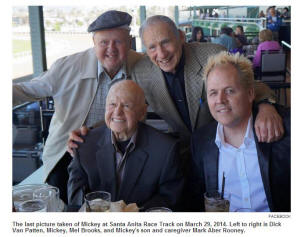 |
|
The last public photo of Mickey Rooney. |
|
|
|
A Pair of Jokers
In the Summer of
1945, two of Hollywood’s biggest stars performed in front of the
troops of the 9th US Air Force stationed at Bad Kissingen. Bob Hope
and Mickey Rooney played BK, a very small town in a large war torn
country and while the story may have been quickly lost in the joy at
the end of the war, those days and visits are certainly something
worthy of recalling now.
From major stars to
minor acts, American entertainers of that era were committed to
bringing jokes, laughter and the old - soft – shoe to the troops
through participation with the United Services Organization, USO,
and the Army’s Soldier Support Companies. Mickey ended up in
uniform and was the king of the Jeep Show circuit - small shows
traveling in jeeps bringing entertainment as close to the front
lines as possible. Bob Hope was the star of the grand revues, the
Camp Shows, that featured a cavalcade of stars and played before
troop audiences in the thousands. Both entertainers could not have
been better cast.
In 1945, Hope, Rooney
and their respective caravans were rapidly crossing the European
theater on separate schedules and it was probably a matter of
coincidence that in the late Summer, both played Bad Kissingen.
Hope was there in mid August, Rooney followed about a month later.
I am sure that Mickey never let Bob forget the sequence and that
Hope, at least on that occasion, had become the “ warm up act “
The story of these
two iconic American entertainers and how they came to Kissingen is
told in two parts.
It Says Here …
Bob Hope - Bad Kissingen - August 1945
The Stars Wore Stripes
-
Mickey Rooney - Bad Kissingen - September 1945
It Says Here …
Bob Hope - Bad Kissingen - August 1945
Actor and comedian, Bob Hope, was the king of the USO Camp
shows and in a career that spanned six decades, he appeared
in 199 of them. He sold out the house in vast military camps
and bases in America, England, Germany, all across the
Pacific - then on to Korea, Vietnam and into the Middle
East. The talent surrounding him changed through the
decades, singers, pretty movie stars and starlets, comedians
and athletes; they were always willing to put on a show for
the troops when Bob came calling. As the faces changed, Bob
was the first to note with a sly smile, the jokes were
pretty much the same - maybe updated a bit but young men
tended to understand the same jokes - appreciated the same
humor across the decades and regardless of the military
theater. Striding on to the stage with the band playing him
in, many of the shows started with the same joke,
“ I’d like to thank the draft for providing such a large and
wonderful audience today and isn’t it a thrill to be
performing in front of the men of the … “
The crowd roared and cheered and Bob Hope was off to the
races, it was that way in August 1945 at Kissingen and that
way fifty years later.
The 1945 European Tour
In early Summer 1945, Bob Hope was temporarily free of
Hollywood requirements and as usual, was working for the war
effort. The mission at hand was fund raising for the Seventh
War Loan Drive and accompanied by his regular radio show
cast, the Pepsodent Players, he was in Washington DC. Among
other events, Hope was feted by President Truman who asked
to see the exact same show that was given for the troops.
Truman was enormously pleased.
Working West, Hope and company performed in Chicago, South
Bend, Sedalia and finally Salt Lake City. These were hardly
single event stops. Most of the time, he was in town for
four or five days of fund raising - he would perform his
nationally syndicated radio show, do guest appearances and
appear at celebrity golf matches. Bing Crosby had a habit of
turning up unannounced and the two would immediately fall
into the comedy routines that had filled movie theaters. The
war in Germany was over and the nation could not be in a
better mood.
The USO was concerned that the hundreds of thousands of
G.I.s still in Europe, either on occupation duty or waiting
transport to the Pacific Theater, should not be forgotten
and they reached out to the top entertainers asking for yet
another big tour. Hope, of course, said yes, he had done a
very similar tour in the Pacific in 1944 and he departed in
late May with most of his usual troupe of players:
Jerry
Colonna
(entertainer) ,
Patty Thomas
, singer
Gale Robbins, musicians
June Brenner and
Ruth Denas
and comedians
Roger Price (comedy) and
Jack Pepper.
This was planned to be a long tour, 2 ½ months and it began
with shows in London and Channel, France. The cast was soon
running into other major USO talent who had committed to
appear at least at some of the tour locations. The Bob Hope
caravan was then off to Amiens and Marseilles where
audiences over one hundred thousand troops were recorded.
The city of Niece was one of the final stops in France.
Next on the agenda were 13 shows in Germany, among the
stops: Bremen, Berlin, Bad Kissingen, Schweinfurt,
Heidelberg, Furstenfeldbruck, Fritzlar, Kassel, Munich,
Nuremberg and Mannheim. The Navy asked him to do a show in
Monte Carlo so off they flew. The tour was so extensive that
back in the USA, his regular radio audience began to
complain that they were being neglected. By the time Japan
finally surrendered, Hope was headed for Austria and finally
Czechoslovakia. Not every American serviceman got to see a
Bob Hope USO Show in 1945 - but he certainly tried.
The Twitter Feed: It Says Here …
Long before the days of Twitter and keeping in touch with
millions of fans with a few key strokes, Bob and his
publicists were well in front of the idea. Syndicated to
hundreds of small town newspapers across the country, the “
It Says Here “ column, written by Hope, kept his fans aware
of his overseas activities and was occasionally used to
recall stateside adventures as well. It was written in that
breezy, joke filled style that very much paralleled his on
stage demeanor but when sent from Germany, he also threw in
some war related facts that readers may not have been aware
of. Not every paper carried each column and sometimes the
dates got badly out of sequence but here is how Hope
reported to the newspapers as his tour arrived in Bad
Kissingen in August 1945.
It Says Here - August 4
( Airborne from Bremen ) Bad Kissingen is the name of a town
not a description of a girl with a weak pucker. ( I just
told that one to our pilot, Lt George McKellar, and he’s
still trying to figure it out too. ) We got away safely this
A.M. after having to go back three times to get out towels.
Over here, everyone carries their own toilet equipment and
it’s quite a novelty leaving the hotel and stealing your own
towels and soap.
Had our last breakfast sadly at the American mess at the
Bremen Rathskeller which is a very fine trough indeed. This
Rathskeller is sort of an underground Brown Derby ( famous
Hollywood restaurant ) with cobwebs. It’s over four hundred
years old and the walls are decorated with murals of fat
characters chasing fatter blonds all of whom seem to have
mislaid their clothing ration books. And down in the sub
basements are huge carved wine casks, seven feet in diameter
that are so old they have to keep them full or they’d
collapse. I could say we have the same things in Hollywood
but that wouldn’t be a nice way to talk about W.C. Fields.
But the place is strictly G.I. now, Pvt Bert Parrish, who
used to be half owner of a New York restaurant, is the
maitre de and he’s really a chow-hound’s delight. The food
is so good, termites are coming out of the walls and making
reservations.
Our plane today was named “ half pint Nina “. Guys here tend
to name everything and they really knock themselves out on
some of the jeeps. Some names I recently noticed: “ Mrs.
Astor’s Horse “, “ Jerky “ , “ Ophelia Bumps “ , “ Dead End
“ , “ Candy “ and “ Ohh La Laa “ and yesterday I saw a
Chaplains jeep names “ Heavenly Daze “. But mostly the guys
like to put a girl’s name on the equipment.
After a couple of years overseas, the name and memory of a
woman becomes awfully important to a fighting man. That name
and that memory are never completely out of his mind and
sometimes the name Margaret, Patsy or Jean is the only
concrete thing he has to link him with home and the life he
used to know. These boys do a lot of sitting and waiting and
a lot of planning over here - and the planning is all built
around those names they write on the jeeps, their planes,
their tanks and their guns.
Got to cease now, we are dropping down. I can tell because
my ear drums just met together in the middle of my forehead.
Again.
It Says Here - August 5 ( appeared in US papers on Aug 19th
)
Bad Kissingen - We are putting up here at a Press Camp which
formally was a sanitarium. I won’t say what kind on
sanitarium it was but it has padded doors and bell - hops
all wearing white coats - they keep looking at me and
murmuring “ Ahh … re-conversion and a new patient already! “
The Bad in Bad Kissingen means bath but so far, I haven’t
been able to locate one here. This place is sort of a
Bavarian Saratoga Springs. The Krauts used to flock here to
soak in the mineral water they believed would cure
everything from bunions to marital unfaithfulness. I tasted
some of the water and all I can say is, “ I don’t think it
will replace the old fashion mickey. “
This afternoon, I ran into six soldiers and an officer all
wearing British uniforms and the Star of David shoulder
patch. I stopped to talk with them and learned that the
officer was Cpt. Horter Ishay of the Jewish Infantry
Brigade. Though there were over one million Jews fighting in
the Allied Armies, this was the only independent Jewish
fighting unit. Cpt. Ishay, formerly a lawyer in Jerusalem,
has been in the service five years and is up here now
helping Jewish displaced persons get back to their homes.
Our unit went through its paces this evening up in Bad
Neustadt for some 9th Army Air Force guys and afterwards we
dropped over to the local Enlisted Man’s Club and hoisted a
few beers with the guys. They were very glad to see us,
meaning Neale, Patty, June and Ruth and hated to see us (
the girls anyway ) leave. We all sat at different tables and
gave out the news from the states and signed autographs. (
When it was done, I was ahead by five fountain pens. )
There are a lot of displaced persons here, Poles, Russians,
Czechs, Belgiums, Slavs - and during the show, a bunch of
them were hanging around the outskirts of the crowd and
although they did not speak any English, they seemed to be
having a big time and laughed very loudly any time anyone
else did. In fact I signed five of them up for my next
Winter’s radio audience - if we ever get there.
It Says Here - August 6
Bad Kissingen - This morning I went for a ride in a “ droop
snoot “ ( Note: this term has nothing to do with Jimmy
Durante. ) A droop snoot is a P38 with guns and armament
removed and a glass enclosed seat stuck right in the nose.
Major Johnny Hatch of Decatur GA, commander of the 474th
Fighter Squadron asked me if I wanted to go up in one and I
immediately said “ Sure! “ ( I’m having my head examined
tomorrow. )
Sitting in the front of one of those things, kids, is like
riding on the handlebars of a bicycle with superman
peddling. We really traveled and I know because I finally
had the courage to open my eyes.
I had met Johnny’s father in the Pacific and every time he
started into one of those dives, I wished his dad had
remained a bachelor. It really is a thrill pulling out of
one of those dives. Of course it wasn’t much fun when we
landed and I had to hang by my heels for an hour to let the
blood drain back into my head.
On our way into Schweinfurt, we flew over a big ball bearing
factory that cost us so much to put out of commission - more
than 100 flying forts in just one raid. We could see the
remains of the ack - ack gun emplacements around the place
and from what was left, get an idea of the tremendous amount
of flack the Germans shoved up at our guys there.
After the show, we stopped in at an enlisted man’s mess that
was being decorated in a big way. An Italian prisoner of war
was busy painting a huge and very good mural across one wall
showing the Statue of Liberty surrounded by waving American
flags.
During chow, I bumped elbows with another Hollywood boy, Sgt
Bill Cleland. Bill is the weatherman here but they are
having a lot of trouble with him. No matter what the
instruments say, it is difficult for a Californian to
predict rain.
We had a great time talking with the boys of the 474th and
after lunch, they presented our troupe with a mascot. It was
a four month old Dachshund which after no particular
deliberation, we promptly named “ Hildy. “ She is in my room
now and looks particularly innocent chewing on my last pair
of clean socks. She also seems very intelligent and ( opps!
) of course she still needs a little training.
From Schweinfurt we came back to Bad Kissingen and did an
evening show in the courtyard of a Red Cross building, a
former mineral water joint which is only a trifle smaller
than the White House, for 8000 men of the 9th Air Force
Headquarters. What a crowd - haven’t seen that many Colonels
since I last played Iowa - can you believe I got laughs with
that cornball joke?
And afterwards we ( Ooops! ) - well, there’s no use waiting,
I’ve got to take Hildy for a walk and I’ll have a little
talk with her.
It Says Here - August 9
Stalin’s Picture with laundry
Erlangen - We are putting up here in a little random hotel
that reminds me of my vaudeville days. There’s only one bath
in the whole place but it really is a godsend because there
is hot water and that is a rare phenomenon in Germany.
Everyone here is really ready for that treatment you need
when your best friends just won’t tell you and about that
certain aroma, and Jerry, Jack, Roger and Mike Cullen and a
couple of other characters who just wandered in off the
street are all trying to get in the tub at once.
We left Bad Kissingen this morning after spending an extra
fifteen minutes trying unsuccessfully to get Olga, a cute 20
year old Russian who works at the sanitarium to take some
money after doing a big stack of laundry for us. But she
wouldn’t touch it. She just kept saying, “ I do it for all
the fine artists. “ I guess it was a pretty good idea that
we told her we were the Don Cossack Chorus.
She really did a swell job with the laundry though. I just
couldn’t figure how she managed to scorch a picture of
Stalin on to each of our shirts.
We flew to Darmstadt for our next show which was just like
some we had done in the South Pacific. It was back in a huge
forest and we went on for them in a clearing set up for the
415th P61 night fighter squadron with guys hanging from the
trees all around us. It was a great day for the Tarzans. And
quite a novelty for us to have an audience climb trees, we
haven’t seen that since we last played Tarzana. ( a wealthy
neighborhood in Los Angeles)
Between acts I chatted with Captain Mat Gilstrap and Lt Hank
Long, Advisory Editor for the Germany edition of Stars and
Stripes. Everywhere you go in Europe you find guys reading
one of the five different editions they print here and
everyone has a lot of respect for it.
Along with all the other tourists over here, this enlisted
man’s paper is our only contact with what’s going on at home
and the rest of the world. it’s a good contact and they do a
fine job. The Germany edition alone, now printed on the
presses of the once famous Frankfurter Zeitung runs off
200,000 copies per edition and gets them all to G.I.s the
same day as printed.
Their offices are over a big brewery and they have to have a
man standing by to blow the beer suds off the first 300
copies.
Had to send Hildy, our Dachshund mascot, back to the guys in
Schweinfurt this morning. We were getting very fond of each
other but when I woke up, she was having breakfast on my
suitcase. ( She was really crazy about all the cardboard! )
I’d better halt now and get in line for a bath before the
ring around the tub gets so thick that there’s no room for
the water … what grimy little there is.
Back in the USA
In the Fall, the tour finally ended and the usual cast set
sail for home. The only media coverage of Hope’s Bad
Kissingen show were the glimpses provided in the It Says
Here column and no photographs have surfaced.
An audience of 8000, all from the HQ 9th Air Force crammed
into the riverside promenade? Maybe although by the time the
small town newspapers that ran the column had read,
transcribed and then typeset the wire copy - mistakes could
have been made. An audience of 800 seems more plausible but
this in no way takes anything away from his efforts.
Although Bob Hope never served in the military, he was an
ardent supporter of the USO and did more than ten men in
helping it achieve goals of improving troop morale.
The next few years saw Bob Hope run up a string of hugely
successful movies with Bing Crosby as well as continued
success on the stage and radio. The bond drives, USO Camp
Shows and all those performances in front of all those
troops were behind him, or so he thought but in 1950 and a
new war in Korea, the USO was reconstituted and the first
person they called was Bob Hope.
There is a wealth of information related to Bob Hope and his
grand participation with the United Services Organization.
A good place to start is here. http://en.wikipedia.org/wiki/United_Service_Organizations
To hear
a complete Bob Hope USO Show from 1945 and see a montage of
USO images.
Bob Hope Show in the South Pacific 1944 on YouTube.
There is good coverage of the 1945 USO European Tour in
period newspapers and this book provides some detail.
Bob Hope: A Life in Comedy
Robert W Faith
Da Capo Press
ISBN: 030681207X
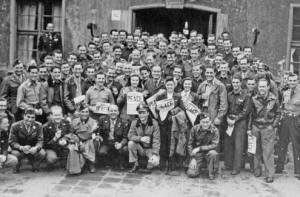 |
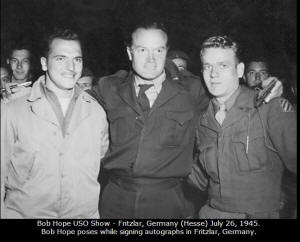 |
 |
|
Bob Hope and crew in the center of the image, taken
the day Japan surrendered while the tour was at USAF
station Sandhofen, August 15, 1945. |
Bob
Hope and his biggest fans |
Bob
Hope and Ann Jillian at his final USO performance at Bahrain. |
The Stars Wore
Stripes
In 2014, the US Army Soldier Shows Detachment, part of the Army
Morale, Welfare and Recreation Programs will play over fifty
stateside dates - soldiers entertaining soldiers and family
members. Troopers wishing to participate as entertainers can apply
for an audition through their chain of command and if selected,
spend a year honing their talent and then performing song and dance
numbers, choral assemblies and skits. What a wonderful opportunity
for that guy or girl always on stage in high school.
Youth never looks too deeply to the past so here is the story of how
the Soldier Show Detachment began, the biggest star and how a
trooper small of stature played it big on the stage and brought the
crowd to its feet in Bad Kissingen, 1945. It really did begin with
Mickey Rooney.
Mickey Rooney
- An American Original
He was Hollywood’s top box office draw in 1939 while working a
standard scale contract at MGM. He received his first on stage
credit at the age of three and was still cashing checks through
early 2014. He had that impish face with a ton of energy, the boy
next door who could sing, dance, romance and tell a joke, a mix of
innocence and sly devilment, a squeaky clean romantic and a hopeless
womanizer. Mickey did it all in Hollywood’s golden era, his face
was seemingly always on screen, his face was seemingly always on the
cover of the scandal magazines.
Mickey went through lots of changes and staged multiple come -
backs, effortlessly going from screen to radio to stage to voice
actor and then a final bow testifying before Congress about abuse of
senior citizens. They broke the mold when he showed up. He dated
all the top starlets, married icon Ava Gardner and then divorced
her, earned millions, spent millions, paid alimony to multiple ex
wives. And through all of this, he told the standard self
depreciating jokes the audience loved:
“ I’m the only guy you’ll meet with a marriage license in my pocket
made out : To Whom it May Concern “ .
“ You know, all these divorces, when I married these women, it made
them happy, when we divorced, it made them happy … when their first
alimony check arrived, it made them happy. All I do is make women
happy! “
Mickey Rooney pretty much did it all - and this is to include as an
enlisted soldier, telling cornball jokes, singing songs, banging on
the hood of a jeep with drum sticks and entertaining troops just
behind the front lines. And did I mention - he staged a musical
review that ran for a week in Bad Kissingen in September 1945?
Before you and I were in BK, Mickey Rooney was Boffo in BK.
Hollywood
Hollywood went to war on 8 December 1941 and from the studio board
rooms to the screening rooms to the dressing rooms - everyone was
expected to do their part. The moguls would produce patriotic
movies even as their top leading men lined up at the recruitment
offices. The experienced film technicians of draft age soon also
departed. Hollywood was a dream factory run by old men and populated
by female stars and starlets, with middle aged men both in front of
and behind the cameras - and then there was Mickey Rooney, ever
young, America’s favorite star.
His string of Andy Hardy movies and similar projects was quite
successful coming into the war years and at MGM, eager to pack
theaters and short of male leads, Mickey was the go to guy. It
helped that his draft number was high; he missed the call - ups of
1942. Content to do his studio work and to pitch in as a touring
troop entertainer, Mickey split his time between the sound stages,
the race track, chasing and then marrying the beautiful bit part
player Ava Gardner and doing guest appearances at major Army camps
throughout the nation. He would sing, play the drums with the band,
tell jokes, banter with the crowd - anything to entertain the ranks
of soldiers. This is how Mickey passed the middle war years.
Interestingly, his box office appeal began a downward trend as the
war dragged on. Maybe America, in too somber a mood to accept the
light hearted romantic films that were his specialty plus the drama
of the now unhappy marriage to Ava, had just grown tired of “ the
boy next door “. He did have a critical success in the film, The
Human Comedy, but on the whole, while he remained popular, many of
his movies were not.
Rooney’s pre draft medical status wavered from 1A to 2A,
temporarily exempted due to war effort employment, to 4F, exempted
due to high blood pressure. When the divorce from Ava finalized in
early 1944 and the movie audiences clearly looking for a change, -
Mickey was back to a 1A status and the studio was not going to fight
for another exemption. He reported for basic training at Fort Riley
Kansas in June 1944.
Andy
Hardy Goes to War
The published accounts all agree that Mickey Rooney received little
or no special treatment at basic training although on more than one
occasion - he was invited to make an appearance at the Officer’s or
NCO Club. There are conflicting reports that he went AWOL once in a
last attempt to salvage the relationship with Gardner, his
autobiography recalled the incident as an authorized leave to visit
his mother in California. On the whole, he was considered a very
good soldier.
Following basic, Mickey was to be trained in chemical warfare but
his orders changed and his next stop was Camp Seibert, Alabama.
Here the Army was pooling musicians, actors, singers, anyone with
talent and in uniform who would provide entertainment at the front,
much too close to the combat for the regular civilian USO
personnel. The unit was given the title: the Soldier Show Company.
As the major talent in this unit, Mickey was responsible for pulling
the diverse group of fellow entertainers into a cohesive group
capable of putting on shows in the field. When not at the rehearsal
hall with Jimmy Cook, a noted Big Band musician now troop band
leader, as only Mickey could, he was conducting a whirlwind romance
with the local teenage beauty queen, Betty Jane Rase. They married
after three dates and as the company deployed for Europe in the
early October 1944, Mickey had his show on the road and Betty was
pregnant with their first child.
The USO and the Big
Shows
When America entered the war, among the thousands of areas discussed
and planned for was how to maintain troop morale and consequently
good combat effectiveness in what was clearly going to be a long,
global war. The colonels and general officers looking at this
problem were for the most part, veterans of the First World War, and
they recalled their own experiences. Soldiers who are given some
diversion from the constant strain of battle, some small creature
comforts, a tiny taste of back - home America simply performed
better and the challenge was to invent a system to make this happen
in 1942. The troop morale programs of 1918 were patchwork
assemblies of well meaning civilian and religious groups, special
projects of the wealthy or misguided civil efforts. None of this
would do.
Assigned to the task were two men, Fredrick Osborn, an academic from
Princeton University who was first assigned to the Selective Service
branch and then commissioned as a colonel and promoted to Chief of
the Morale Branch of the War Department and Joseph W. Byron, a
veteran and Military Academy graduate who had left the Army, been
very successful in business and then returned as a senior civilian
procurement advisor. Together, these two men would respectively
build the Special Services Division and the PX system, those two
agencies most closely linked to soldier morale.
The Special Services Division would consist of companies configured
to directly enhance soldier morale in foreign theaters. It took
experimenting to get the framework approved but in general, the
units consisted of platoons and sections each with specific tasks
such as mobile snack bars, mobile PX trucks, a motion picture
projection section, recreational and sports equipment section,
lending library - book give away section and a theater and
entertainment support section. This last section provided
spotlights, loudspeaker systems, props and costumes for the United
Services Organization sponsored civilian entertainers either hired
by the government or volunteering their talents as part of the war
effort. A total of fifty - one such companies were planned and
seventeen were actually deployed to Europe. The officers assigned
to these units trained at Fort Meade and they tried to become
specialists in merging civilian USO entertainment into a military
environment. These companies would soon accompany Divisions, Corps
and Air Forces as needed to augment unit and individual morale as
field commanders saw fit.
In the early days of the war, the system worked well. England was
dotted with bomber and fighter bases, huge cantonment areas filling
steadily with troops destined for the invasion - the camps were
perfectly suited for support by the Special Services Companies but
once the invasion began, troubles, particularly with the live
entertainment sections became apparent. The civilian entertainers
and their big production shows, so popular with the troops, were
simply ill suited for the rough and ready field conditions as the
Allies attacked across France.
Smaller shows were crafted, civilian talent was hired in England and
liberated France but it seemed apparent that the combat troops,
those most in need of a break from their danger and tedium, were
being neglected. Back in America, to solve the problem, the Soldier
Show Company was authorized as part of the Special Services
Division. It consisted of a full complement of fifty - seven
personnel, all experienced entertainers now in uniform to be sent to
Europe initially on a ninety day TDY basis. Mickey Rooney and his
band of players, singers and comedians disembarked their troop ship
and headed for Paris.
The Jeep Shows Hit
the Road
The 6817th Special Service Company was designed to improve support
to USO camp show efforts by consolidating all support into a single
command and this appeared to greatly improve the relationship
between the civilian performers, the Army units served and the
Special Services. The unit was based just outside of Paris and it
was here that Mickey Rooney and the Soldier Show Company joined the
war effort. Reporting also was another famous soldier entertainer,
Red Buttons. Drafted earlier, he had been involved with both
military stage and movie productions. Once free of those
assignments, he was assigned to the Show Company.
Who actually invented the jeep show concept? A couple of Mickey s
biographers give him credit - the Army documents available indicate
that the plan from the beginning was to use the all Soldier Show
Company on a piecemeal basis. The unit was to be broken down into
about thirty, three man teams, each with a jeep and trailer.
Rattling down the roads and trails following as close as possible to
the combat units, the jeeps shows had a master of ceremonies, and
one or two musicians or comedians. Their instruments, a small loud
speaker, a tiny stage platform and the rest of their gear was in the
trailer and they would give impromptu shows for units as small as
platoons, well within the sound of cannon fire. They would sing a
few songs, play a few tunes, mix it up with jokes and banter with
the troops - lead a sing a long and sign autographs when asked.
Naturally, Mickey was the MC of his group but he excelled in all the
tasks - beating out the rhythms with his drum sticks on the hood of
the jeep, leading the songs, telling the jokes and happy stories of
Hollywood and the stars. Never was a man so perfectly configured to
the task, he never complained or asked for special accommodations,
always gave his best and the troops love it. Military photographers
also loved Mickey - there are dozens of photos of his jeep show at
work and little evidence remaining of the other teams.
Now and then, several of the jeeps would converge to create a larger
show when appropriate and the big musical they had planned at Camp
Siebert and then rehearsed in Paris was dusted off on more than one
occasion. This is the contribution Mickey gave to the war effort.
Rooney - Boffo - Bad
Kissingen!
The specifics of Mickey Rooney’s entertainment caravan go cold as
peace comes to Europe in the late Spring of 1945. His biographers
do not go into much detail beyond the fact that he was late in
getting to the war zone and lacked the points for a prompt
departure. It is safe to say that he continued entertaining the
troops in ever larger groups as the jeep shows gave way to larger
productions at the major camps holding soldiers ready to depart
Germany.
The 6817th Company was reorganized into a battalion as it absorbed
the live entertainment support sections of other Service Companies
to include apparently the entire all female Special Service Company,
the last SSC deployed to Europe. At some point that Summer, probably
due to the ever larger audiences, the grand production musical show,
OK - USA, was performed for the troops and this is where Mickey,
the Show Company and Bad Kissingen come together.
Unfortunately, no photos have surfaced from that event but we do
have a wonderful souvenir program from the show that was performed
for a week at the Kurtheater, in front of personnel of the HQ 9th
Air Force and certainly any other soldiers in the area. As you
look at the credits for each number, you can almost imagine how many
of the skits and songs could easily have been performed in the jeep
show days, and how grand the big production with full band and stage
support must have looked on the professional stage at Kissingen.
Briefly looking at some of the names on the program, there was a lot
of Army talent beyond Mickey:
-
Red Buttons had a
long career in movies and TV as a comedian and became a staple
late night guest with Johnny Carson.
-
Bobby Breen was a
noted singer of that era and went on to run an important talent
agency.
-
Gene Fullen spent
his post war career as a Big Band leader and arranger playing in
Las Vegas.
-
Hugh Martin had a
long career on both Broadway and in Hollywood composing and
writing for musicals.
-
A.C. Gannaway
spent a career as a significant Hollywood TV producer.
A number of other named personalities have listed credits as
musicians or arrangers on sheet music dating over three decades.
So What Happened
Next?
Was OK - USA performed elsewhere? Probably but there is no direct
evidence. We do know that Mickey Rooney was assigned to the Armed
Forces Radio Network in the Fall of 1945 and soon was giving daily
broadcasts from Frankfurt. Elsewhere, staffers were busy writing
the After Action Reports for the Soldier Shows and Special Services
Companies that Winter - probably many of the actual participants had
rotated back to the United States by that time and streamed to New
York City and Hollywood to resume their careers.
In February 1946, Mickey finally had enough points to leave
Germany. He was awarded the Bronze Star by General Eisenhower for
his great contributions to unit morale and in early March, was
discharged from the Army and returned to Hollywood, motion pictures,
the women and the horses.
As the Army
mission in Germany changed from occupation to constabulary
to the VII Army and the start of the Cold War, the Special
Services Division, Soldier Show Company and morale services
for the troops evolved. With the units stationed in
permanent barracks, morale services likewise became tied to
each post and the military talent for shows was drawn from
the rank and file. There soon was a USAREUR symphony
orchestra, jazz band and numerous singing combos, all
grouped under a new soldier show concept.
The USO tours
continued to employ civilian entertainers of all levels,
there were the usual big shows with big stars but the talent
still chased out to the remote locations in jeeps on
occasion, even as far as the border camps.
The actual words and music for OK - USA appear to be lost.
To read some of the better Mickey Rooney obituaries, go
here
and
here.
For a very well written history recalling the creation of The
Special Services Companies and the creation of the Moral Services
Division, read:
American Girls, Beer and Glen Miller - GI Morale
in World War II
James J. Cooke, University of Missouri Press
ISBN: 978 - 0 - 8262 - 1948 - 8
To read online about the modern American Army Show Company, go
here |
|